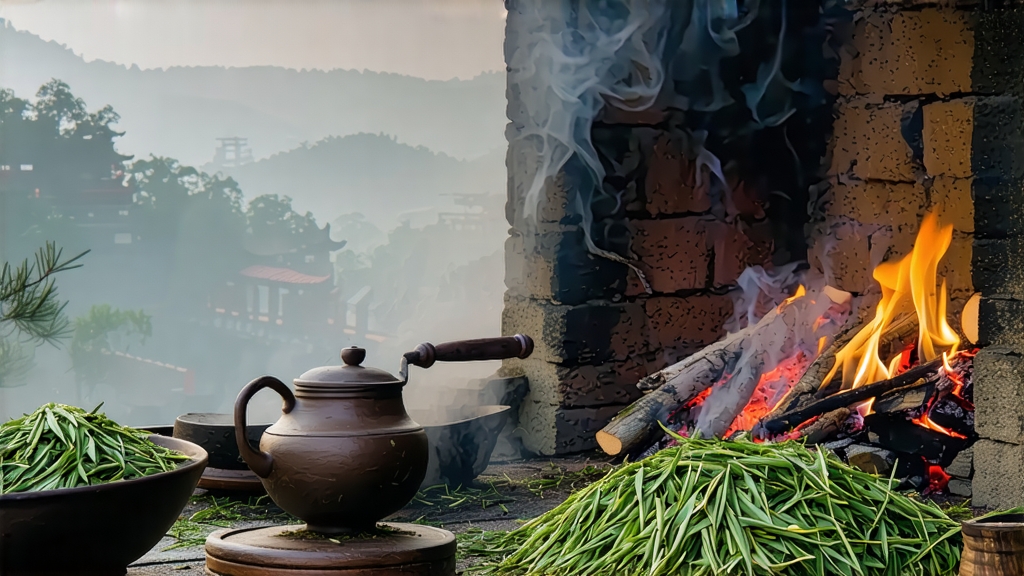
Long before English breakfast tables knew the word “black tea,” caravans carried small, leathery leaves out of the Wuyi Mountains of northern Fujian. Those leaves—twisted, glossy, and impregnated with the scent of fresh pine smoke—were called Lapsang Souchong, the very first fully oxidised tea ever created. International traders later lumped it under the label “Bohea,” a corruption of the local place-name Wuyi, and for two centuries it remained the most expensive and coveted tea in London, Paris and St Petersburg. Today, while mass-market copies flood supermarket shelves, the authentic, craft-made Lapsang Souchong is still produced in a 300-year-old sequence of withering, rolling, oxidising, smoking and charcoal baking that has changed little since the late Ming dynasty.
Origin & Myth
Villagers in Tongmu Guan tell the story of a Qing-era army unit that commandeered a tea factory during harvest season. To save the leaves from spoilage, anxious farmers dried them hastily over fresh pinewood fires; the resulting liquor was unexpectedly mellow, its fragrance reminiscent of longan fruit and campfire resin. The accident became a recipe, and imperial merchants rewarded the innovation with silver. Whether myth or marketing, the tale captures the tea’s dual personality: rugged yet refined, born of haste yet finished with patience.
Micro-terroir
Tongmu Guan sits inside a national nature reserve at 1,200 m, shrouded in fog 240 days a year. The humid air slows photosynthesis, thickens leaf cuticles and concentrates aromatic oils. Indigenous Xingcun Xiaozhong bushes—small-leaf, slow-growing Camellia sinensis varietals—root directly into weathered granite, absorbing minute amounts of potassium and fluoride that soften astringency. Because pesticides are forbidden inside the reserve, insect bites naturally trigger the plant’s defence chemicals, adding honeyed nuance to the finished tea.
Two Families, Two Styles
- Traditional Smoke-Dried (Zhengshan Xiaozhong): leaves are withered over pine embers, oxidised in bamboo baskets, then hot-smoked in wooden sheds lined with fir and masson pine. The final bake is done over charcoal impregnated with pine resin, locking in a tar-less, sweet smoke note that lingers for years.
- Modern Unsmoked (Wuyi Black): developed for the domestic market in 2005, this version skips the smoking step, relying instead on precise oxygen control during oxidation to coax natural fruit and malt tones. It appeals to drinkers who want the mineral backbone of Tongmu without the campfire perfume.
Craft in Slow Motion
Harvest begins around Qingming when buds open into one leaf and a half. Pickers pluck only in the morning while dew still guards the leaf from bruising. Withering happens in an upper loft heated indirectly by pine embers; temperature hovers at 30 °C for eight hours while masters shuffle leaves every twenty minutes. Rolling is done on split-bamboo mats: forty minutes of light pressure to rupture cells without shredding the leaf. Oxidation proceeds in cedar-lined boxes; every 15 minutes the tea is fluffed to oxygenate evenly, turning from jade to mahogany. The critical smoking phase follows: leaves are spread on sieves suspended 80 cm above glowing pinewood logs that have been pre-burned to rid raw resin. A thick, cool smoke permeates the leaf for six hours, paused twice to rest the tea. Finally, the tea is charcoal-baked at 70 °C for ten hours, reducing moisture to 4 % and caramelising sugars that later translate into longan sweetness.
Chemistry of Smoke
The pine species used, Pinus massoniana, is low in tar and rich in α-pinene and longifolene. These terpenes bond with theaflavins during baking, forming novel lactones that yield notes of lychee, whisky and dried rose. Because the smoke is cool (< 40 °C) and resin-free, the tea avoids the harsh phenolics that plague cheaper copies dried over rubber tyres or rice husks.
Grading the Leaf
Top-grade Lapsang is judged by three visual cues: colour called “tiger skin” (black with golden tips), shape like “eyebrow of a phoenix,” and a glossy bloom that holds even in low light. When shaken in a porcelain gaiwan, the leaves